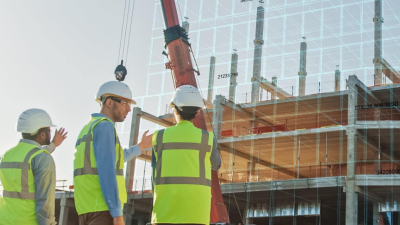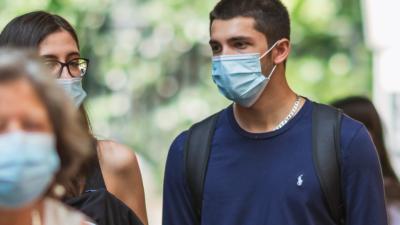
New technologies to improve health and safety performance
Discovering Safety joins forces with Safetytech Accelerator to build a Smarter Regulation Sandbox.
This page is approximately a 9 minute read
This page was published on

New global research with more than 125,000 people in 121 countries has found that a third (34%) of people feel less safe than they did five years ago.
The findings come from the launch of the second edition of the Lloyd’s Register Foundation World Risk Poll, powered by Gallup. Designed to examine people’s perception and experience of risks to their personal safety, the first report of the 2021 World Risk Poll offers insights into how the pandemic has (and hasn’t) shifted the risk landscape since the first Poll in 2019, as well as how this differs across countries and regions.
Overall, the results show that people feel less safe globally than they did in 2019, with mental health and severe weather the most increased experiences of harm specifically asked about in 2021. Despite a global pandemic and millions of deaths across the world, when asked to name, in their own words, the biggest threat to their safety, fewer than one in ten people (7%) cited Covid-19, positioning it outside the top three perceived risks.
The report – A Changed World? Perceptions and experiences of risk in the Covid age – analyses people’s experiences with, and perceptions of, other commonly faced risks. These include workplace harm, crime and violence, and road traffic collisions.
The World Risk Poll is designed to provide insight for policymakers into which risks are most affecting the lives of populations across the world, and our findings will help them work with communities to make people safer.
The latest World Risk Poll paints a detailed picture of people’s attitudes towards risk in the wake of the Covid-19 pandemic. In the midst of a global crisis of this magnitude, people continue to face many other risks that demand their attention, and which shape their decisions and opportunities.
Globally, especially in regions that already face widespread poverty and instability, governments and other policymakers must work with communities to build strategies to protect people from future pandemics that also account for the other risks they may now find themselves even more vulnerable to.
The World Risk Poll found that the percentage of those who felt ‘less safe’ than they did five years prior had increased from 30% in 2019 to 34% in 2021. The percentage who felt ‘more safe’ remained unchanged at 27%.
The regions that experienced the biggest increase in respondents who feel ‘less safe’ than they did in 2019 were Central/Western Africa and South-eastern Asia, both of which have seen an increase of more than 10 percentage points.
While the report shows a slight but significant increase in people feeling less safe, it also highlights numerous contributing factors, including political and socio-economic. The data show that people who view violence or political instability as their greatest risk were most likely to feel less safe than five years ago.
In Latin America, for example, where almost half (47%) of those aged 15-29 named crime and violence as the greatest threat to their safety, over a third (37%) of the population said they would move permanently to another country if given the chance – compared to 16% globally.1
The report also analyses the so-called ‘perception gap’, comparing the risks people fear with those they experience. For example, 19% of global respondents said that they have experienced violent crime or know someone who has, however a much higher percentage of respondents (32%) were ‘very worried’ about such harm.
Work-related harm, meanwhile, appears to be largely underestimated globally. Almost a quarter (24%) of people worldwide said they had experienced or knew someone who had experienced serious harm from their work in the past two years. However, fewer than one in five (19%) said they were very worried about such harm. Italy is the most pronounced national example of this trend, with more than a third (36%) having personally experienced harm from work – and a further 18% knowing someone who has – but only 16% saying they are very worried about it.
There are many contributing factors to this ‘perception gap’. The prominence of violent crime in the media, for example, may lead respondents to believe they are more likely to experience it.
“People’s concerns about a risk are not just based on how likely it seems but also on how bad it seems” said Wändi Bruine de Bruin, Provost Professor at the Price School of Public Policy and Dornsife Department of Psychology, University of Southern California. “People tend to worry more about risks that feel more dreadful, uncontrollable, and potentially gruesome. And those are also the kinds of risks that get more media attention. So, that probably explains why most people worry more about getting harmed by violence than about getting harmed at work.”
Perhaps surprisingly, Covid-19 is only the fourth most commonly perceived threat (named by 7% of respondents globally), despite the death toll, long term health consequences, and almost two years of lockdowns and other restrictions in many places around the world.
According to the report, there are a number of reasons for this, including more immediate risks being front of mind. In the USA, for example, 5% of respondents named Covid-19 as their greatest threat, despite having one of the highest infection rates. This could at least partially be due to other significant national events, such as the murder of George Floyd or the attack on the Capitol in January 2021, affecting responses.
The report also highlights that those from lower income countries were even less likely to name Covid-19 as their greatest threat, as is the case in Central/Western Africa, where just 1% of respondents did. Like the USA, other circumstances, such as the wave of violence and instability that gripped Nigeria, the region’s most populous country, in 2021, could be part of the reason why Covid-19 did not score highly in people’s fears.
Despite being most at risk, older generations (aged 65+) were more likely to cite other personal health conditions (18%) over Covid-19 (5%) as the greatest risk to their safety.
The report demonstrates work-related harm remains one of the most underestimated risks globally. In 2021, almost a quarter (24%) of people worldwide said they or someone they know had experienced serious harm from the work they did; however, just 19% said they were ‘very worried’ about such harm.
Italy is the most pronounced example of this trend; more than one third (36%) of Italian workers say they have experienced work-related harm – and a further 18% say they know someone who has – but only 16% are ‘very worried’ about such hazards.
Meanwhile, worry about work-related harm was highest in lower-income regions. More than a third of people said they were very worried about work-related harm in Central/Western Africa (37%) and Southern Africa (34%), closely followed by South Asia (32%) and Eastern Africa (30%). In comparison, fewer than one in ten respondents in high-income regions like North America (7%) and Northern/Western Europe (6%) expressed similar concerns, creating a stark contrast between regions.
Low-income workers are also more likely to experience work-related harm. A quarter (25%) of workers worldwide who said they were finding it ‘very difficult’ to get by on their current income had experienced serious workplace harm in the past two years, compared to only 9% of those who said they were ‘living comfortably’ and 10% who were ‘getting by.’
The proportion of people globally who had experienced, or personally knew someone who had experienced, harm from mental health issues in the past two years rose from one in five (20%) in 2019 to a quarter (25%) in 2021.
There is also a clear correlation between the resources devoted to mental health and how it affects those living in a specific region or country. The report notes that people in low- and lower-middle-income countries – which are least likely to offer mental health services – are more likely to have experienced serious harm from mental health issues in the past two years than those in higher income countries.
Mark van Ommeren, Head of the Mental Health Unit at the World Health Organisation, said: “The global increase in experienced harm from mental health issues shown by the World Risk Poll adds to a growing body of evidence that the Covid-19 pandemic has had a severe impact on the mental health and wellbeing of people around the world.
“We have seen rates of already-common conditions such as depression and anxiety increase, while access to already-scarce mental health services has been further impeded. As the Poll shows, this is a truly global issue, and yet mental health is still neglected by most societies and health systems, putting millions of people around the world at increased risk of harm.
“Ultimately, there is no health without mental health, and so countries and policymakers in all countries must make a concerted and renewed effort to address the issue.”
As many countries ramp up efforts to tackle climate change and cope with its consequences, the World Risk Poll demonstrates the importance of education when it comes to perceptions of climate change. The report shows that more than two thirds of people (67%) viewed climate change as a threat to their country, including two in five (41%) who said it was a “very serious threat”. People in high-income regions were most likely to say this – for example, the figure is highest in Southern Europe (74%) and lowest in Northern Africa (29%).
Professor Bruine de Bruin commented: “Climate scientists have been warning about climate change for decades. Public opinion initially did not reveal much concern, including in the 2007 Gallup World Poll. The 2019 World Risk Poll marked a big shift and showed that over two thirds of people thought of climate change as a threat. That figure remains similar in 2021,
despite the pandemic and associated economic problems, which suggests that climate change remains front of mind for a majority of people across the world.”
However, people who have experienced or are worried about severe weather events are more aware of climate change and more likely to see it as a serious threat – though again, education plays an important role. 61% of people with at least post-secondary education who had experienced harm from severe weather viewed climate change as a very serious threat, compared to 39% of people with primary education or less who had also experienced harm from severe weather.
“People are more likely to be concerned about climate change when they have experienced severe weather, and when they have the education to recognize it is climate change”, Professor Bruine de Bruin added. “Climate change communications have likely maintained this educational barrier. Climate change communications are often written at the university level and use terms such as ‘adaptation’ and ‘mitigation’ that many people find confusing. So, this finding really highlights the importance of making climate change easier for everyone to understand – and act upon.”
Funding is available from Lloyd’s Register Foundation for further research and interventions using World Risk Poll data to reduce risk. To find out more, visit the World Risk Poll website.
[1] Figures on willingness to move to another country are from the 2021 Gallup World Poll.
Copyright: Shutterstock: Wei Huang
Figures on willingness to move to another country are from the 2021 Gallup World Poll.